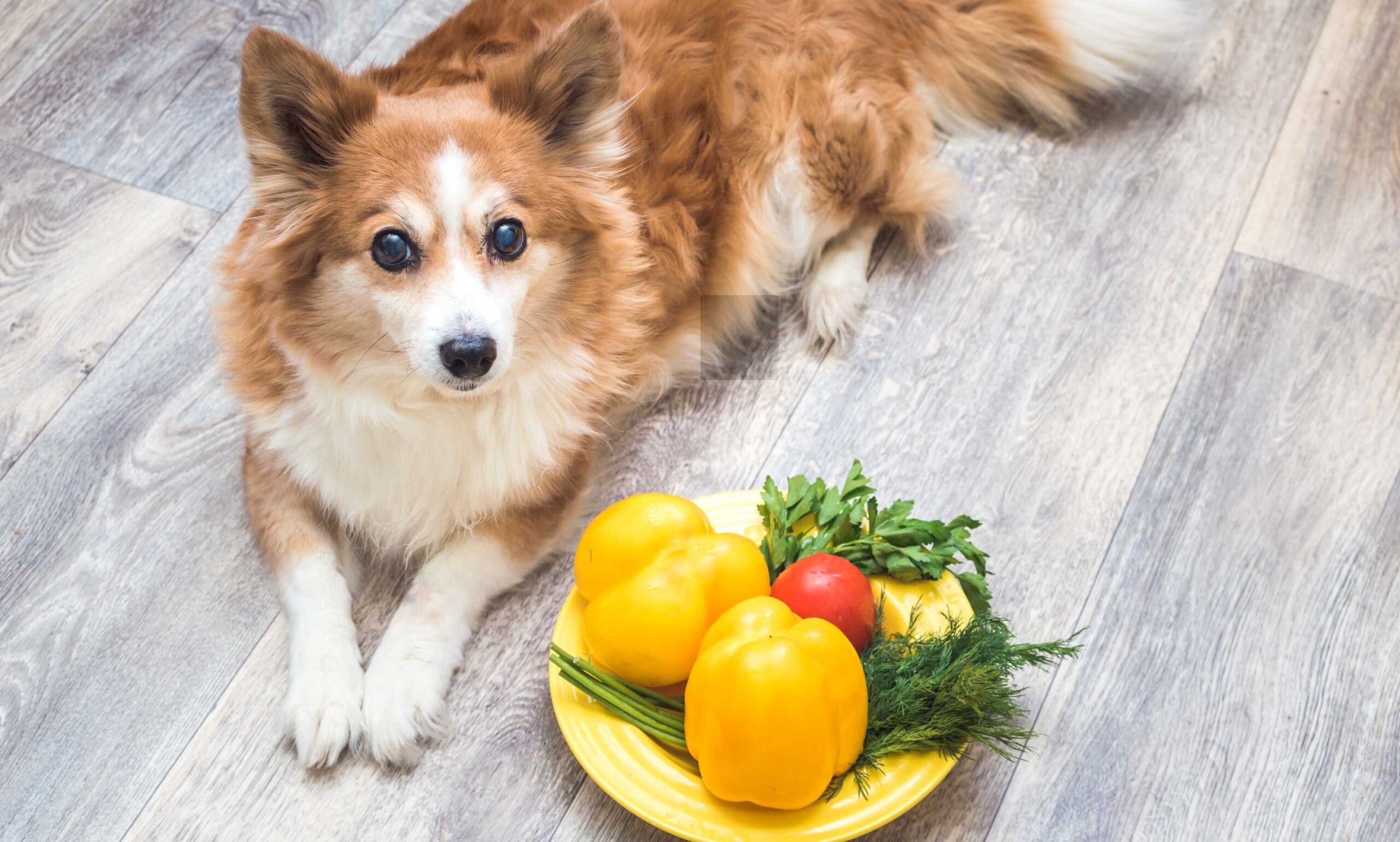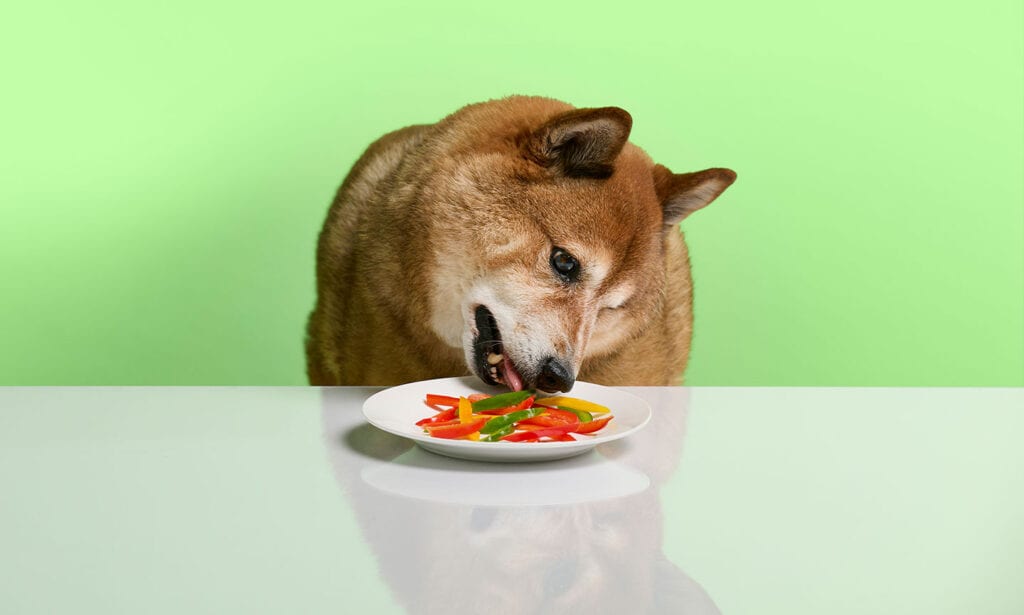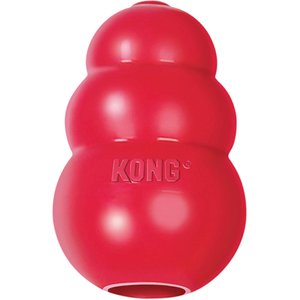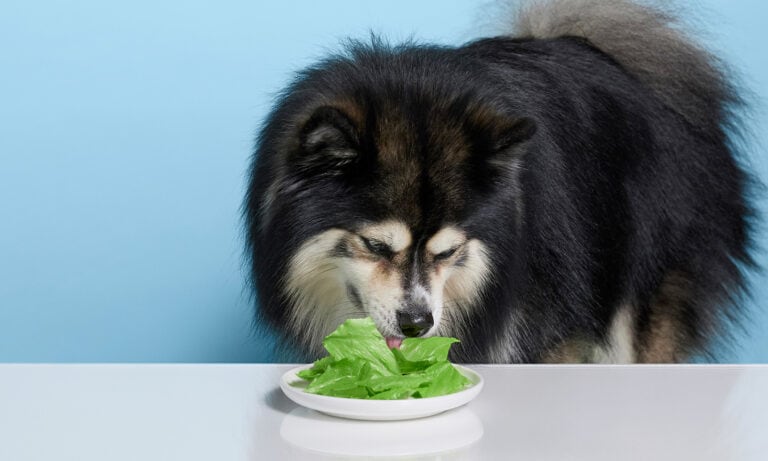As you dice up some crisp bell peppers for a dinner salad, you notice a curious canine nose following your every move. This may cause you to wonder, “Can dogs eat bell peppers?”
Good news, pups—the answer is yes! Bell peppers are one of the many fruits dogs can safely consume. They’re a low-calorie food brimming with nutrients, fiber and antioxidants, all of which can contribute to your dog’s health.
We spoke to a vet expert to learn about the benefits of bell peppers for dogs and how to incorporate this colorful, crunchy fruit into your pup’s diet.
Before serving any new foods to your pet, consult with your veterinarian first.
Expert input provided by Dr. Lisa Fiorenza, DVM, veterinarian at Longevity Veterinary Center in Whippany, New Jersey.
How Much Bell Pepper Can My Dog Eat?
As a guiding principle, dog treats and human food, including bell peppers, should constitute no more than 10 percent of your dog’s daily calorie intake, with the remaining 90 percent coming from nutritionally-balanced dog food.
That said, bell peppers are very low in calories—about 40 calories for one medium red bell pepper. So, technically, you could feed your dog quite a bit of bell pepper, but it’s best to stick to smaller amounts, as eating too much could cause an upset stomach.
- For small dogs, a few small pieces of chopped bell pepper will suffice.
- For large dogs, they can have up to half a small pepper.
As with any new food, start with small amounts to see how your dog reacts. If they don’t show any signs of an upset stomach, such as vomiting, diarrhea or poor appetite, you can gradually increase the portion. If these symptoms or other adverse reactions occur, discontinue the bell pepper and check in with your veterinarian.
Feeding Your Dog Bell Peppers:
6 Ways to Serve the Crunchy Fruit

1Feed as a Refreshing, Raw Snack
If your dog loves crunchy treats, they’ll probably enjoy munching on raw bell pepper.
Simply wash the bell pepper thoroughly, remove the stem and seeds, chop it into bite-sized pieces suitable for your dog’s size.
2Steam for a Softer Snack
While many dogs will happily crunch on raw bell pepper, some might prefer it cooked.
Lightly steaming the bell pepper can soften the outer skin of the bell pepper and make it more appealing to dogs who aren’t fans of the crunchy texture or those with difficulty chewing. The steamed bell pepper can be served as-is, added to their regular food or blended with a dog-friendly broth to make a puree.
3Use as a Meal Topper
Finely chop some bell pepper and sprinkle it on top of your dog’s regular food. This is a great way to add a burst of extra nutrients.
4Make Stuffed Bell Peppers
Prepare a dog-friendly stuffed bell pepper by following these steps:
- Remove the top of the pepper and the seeds inside the bell pepper.
- Fill the pepper with a mixture of dog-safe veggies and a bit of their regular dog food.
- Bake it in the oven at 350°F until it’s soft, about 20 minutes.
- Remove from the oven and let cool.
- Cut off an appropriately-sized portion based on your dog’s size—and serve!
Note: Do not add any seasonings, especially garlic or onion, both of which are poisonous to dogs.
5Freeze for a Refreshing Treat
Freezing small pieces of bell pepper can provide a crunchy, refreshing treat, especially in warmer weather.
6Stuff in a Toy
If your dog enjoys interactive food-dispensing toys, like KONG Classic Dog Toy, bell peppers can be a great addition to the filler you already use.
Simply mix chopped bell pepper with whatever you usually use as a filler (like KONG Stuff'N Easy Treat or peanut butter) and insert the mix into the toy.
Not only will your dog get the physical and mental stimulation of working to get the food out, but they’ll also be rewarded with a flavorful and vitamin-packed treat.
The Benefits of Bell Peppers for Dogs
Incorporating occasional bell pepper snacks into your dog’s diet can provide several nutritional and health benefits, including the following:
- Rich in vitamins and minerals: Bell peppers are rich in various vitamins, especially vitamins A, C, E and B6. Vitamin A supports eye health, vitamin C boosts the immune system, vitamin E promotes healthy skin and coat, and vitamin B6 is important for the nervous system. Bell peppers also offer a significant dose of potassium, an essential mineral.
- Full of antioxidants: Bell peppers, especially red ones, are loaded with antioxidants, including beta-carotene and lycopene. These antioxidants can help fight off damaging molecules called free radicals, potentially reducing the risk of certain diseases.
- High in fiber: Bell peppers are a good source of dietary fiber, which can help regulate your dog’s digestion and aid in maintaining a healthy weight.
- Low in calories: Despite their nutritional richness, bell peppers are low in calories. This makes them an excellent guilt-free treat for your furry friend, especially if they need to drop a few pounds.
- Hydrating: Bell peppers have a high-water content, providing an extra source of hydration for your dog.
- May support joint health: The antioxidants and anti-inflammatory nutrients in bell peppers may help alleviate symptoms of arthritis in dogs.
The Risks of Feeding Bell Peppers to Dogs
Bell peppers are generally safe and beneficial for dogs. However, there are a couple of risks to keep in mind, including the following:
- Digestive issues: Eating too much bell pepper at once may cause digestive upset in some dogs, leading to symptoms such as diarrhea or vomiting. Introduce bell peppers slowly and in small amounts to allow your dog’s digestive system to adjust. Also, while the seeds and stems are not toxic to dogs, they can be difficult to digest. Always remove them before feeding.
- Choking hazard: Large pieces of bell peppers and the stems can pose a choking hazard, particularly for smaller dogs. Always cut the bell pepper into appropriate bite-sized pieces and remove the stem (and seeds) before feeding it to your dog.
FAQs About Bell Peppers and Dogs
Q:
Are bell peppers toxic to dogs?
Q:
Which bell pepper is the healthiest?
Q:
What is the best way to cook bell peppers?
A:
The best way to cook bell peppers for dogs is to lightly steam them without adding any oils, seasonings or spices. Here’s how:
- Cut the bell pepper into bite-sized pieces after removing the seeds and the stem.
- Place the bell pepper pieces in a steamer basket over boiling water.
- Cover and let them steam for a few minutes until they’re soft but not mushy.
- Allow the bell peppers to cool before serving to your dog.
Q:
Can dogs eat other types of peppers?
A:
While dogs can safely consume bell peppers, other types of peppers, particularly spicy peppers like jalapeños, habaneros or chili peppers, should be avoided.
These hot peppers contain a compound called capsaicin, which can cause significant discomfort and digestive upset in dogs. Symptoms of capsaicin ingestion can include excessive panting, drooling, stomach pain, indigestion, diarrhea and vomiting.
Explore Other Dog-Friendly Produce
More fruits dogs can eat:
Share:












